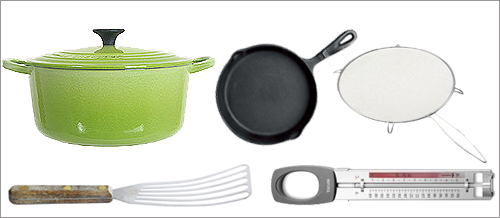
Ready, Set, Fry
We're fearless fryers. In Vol. N° 6, The Grocery Store, we deep-fry tender, flour-dusted pieces of cod for Fried Fish (page 73) and turn panko-crusted Fish Sticks (page 75) into crunchy perfection. We shallow-fry stuffed chicken breasts when making Chicken Cordon Bleu (page 82) and Chicken Kiev à la Canal House (page 84). We don't use any fancy equipment, just some trusted tools for the job. And we get nice and organized right from the start—food all prepped, frying "station" in order—so when we're ready to start cooking, all our focus is on the hot oil and the food we're about to fry. Here's what we like to use for our batterie de cuisine (plus a few tips) for successful frying at home:
CANDY THERMOMETER: We're fans of using a wooden chopstick to check if the oil is hot enough for frying. The method goes like this: Dip a wooden chopstick into the hot oil until the tip touches the bottom of the pot. If bubbles form right away around the tip—lots of bubbles, like champagne—start frying. But more often than not, we rely on the accuracy of a candy thermometer that measures temperatures from 100°–400° to know just how hot the oil really is. Some foods fry beautifully at 350°, others need a higher temperature to brown the crust and cook the interior just so. We clip the thermometer to the side of the pot and keep an eye on it when heating up the oil and while frying, adjusting the heat as necessary to maintain the optimum temperature. The safest candy thermometers are the ones housed in stainless steel. They can take knocking around the kitchen better than the prettier unprotected glass tube thermometers which can shatter easily.
FISH SPATULA: We tend to reach for our metal fish spatula rather than a slotted spoon to lift fried food from the hot oil. Its long open slots allow the oil to drain back into the pot better than a slotted spoon does, which makes oil pool around the food. Look for long-handled versions to keep you far away from any splattering oil.
METAL COOLING RACK: It's tempting to drain fried foods on soft, absorbent paper towels, but the best way to let the oil drain off while keeping the fried food crisp is to use a metal cooling rack. Set the rack over a paper towel–lined sheet pan. It's ready to receive.
OIL: We like to fry in oils like grapeseed, safflower, and peanut oil because of their ability to get very hot before reaching their smoke point (the temperature at which the oil begins to smoke, its chemical composition begins to decompose, and its flavor turns bitter). But they can be pricey. The grocery store always has plenty of inexpensive canola and vegetable oil. These two are good all-purpose oils that can take the heat and are easy on the old pocketbook.
POTS & PANS: Heavy is the way to go. We use a narrow, deep, heavy pot for deep-frying (that is, when the food is completely submerged in or floats on the surface of the hot oil). Pots that are cast iron or enameled cast iron are great for this. Choose a heavy, deep skillet—cast iron is the best—for shallow-frying (when the food is only partially covered by the hot oil). There's more stability when using a heavy pot or pan on top of the stove, and the weight prevents the oil from spiking as it heats up. Plus, the weight of the pot helps keep the temperature of the oil constant once it reaches the temperature you want.
SPIDER SKIMMER: This wire basketlike skimmer with a long metal or wooden handle can scoop up a batch of small pieces, like french fries, from the hot oil and its open weave lets the oil drain away quickly.
SPLATTER GUARD: As food fries in hot oil, moisture is released and tiny beads of oil go flying into the air. You can't stop the splattering but you can contain it. That's why we like to fry with our splatter guard. The fine-mesh screen keeps oil at bay while still allowing steam to escape. Best of all, it keeps our stovetops free and clear of grease. Look for guards with fine stainless-steel mesh and little feet around the perimeter that keep the greasy screen from touching the counter.
TONGS: We can't do without our tongs. They're perfect for grabbing and turning bigger pieces of food in the hot oil. We have several pairs of varying lengths, but the 12-inch-long ones are great for keeping a comfortable distance from splattering food as it fries. Look for the self-locking option to keep storage a snap.
WARM OVEN: Fried food is most delicious when eaten hot. But there are times when it takes several batches of frying before there's enough food to serve. So, while we continue to fry, we keep the finished food hot in a 200° oven on a cooling rack set inside a baking pan.
A WORD ON SAFETY: We always keep a lid close by as we fry because although this has never happened to us, oil can catch fire. If it does happen, turn off the heat immediately and cover the pot or skillet with the lid; the lack of oxygen will suffocate the flames.
